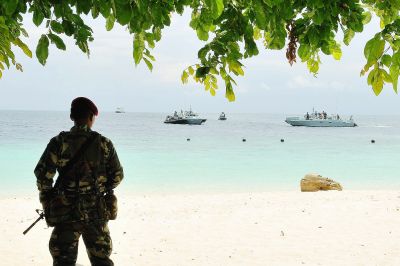
April 2013
As with many countries in Southeastern Asia, maritime security is a great concern and even greater challenge to the country of Malaysia. The territory of the country is divided between two regions– peninsular Malaysia, which is located on the southern tip of the Malay Peninsula; and Malaysian Borneo, located on the north of the Island Borneo.
Unlike archipelago nations like Indonesia or the Philippines, policing the water around a larger land mass, with no connecting waterways presents a specific challenge. This challenge is increased by the fact that including their Exclusive Economic Zone, Malaysia needs to police 574,000 square kilometers of ocean, which is nearly twice the size of the land territory of the country. Finally, because of the distance between east and west Malaysia, vessels cannot quickly travel between the two, making it necessary to have an entire fleet for each half of the country.
Aside from combatting the rising threat of piracy in the Strait of Malacca — a narrow yet vital waterway between Malaysia and Indonesia that has become a hotbed for piracy — Malaysia is also heavily invested in protecting waters it claims as it’s Exclusive Economic Zone (EEZ). These waters are definitely important for fish resources, but the possibility remains that there may be oil or other more valuable stores of material underneath the ocean.
The geography of the situation requires that Malaysian maritime authorities police two areas of equal importance. They must defend the population and industry of the coast from piracy, drug trafficking and other illicit activities, but they must also police the open waters of their EEZ, making sure regional aggressors have no room to make conflicting claims.
The duties of maritime security are split between the Royal Malaysian Navy, Royal Malaysian Air Force, Malaysian Maritime Enforcement Agency and Marine Police. The Royal Malaysian Navy, which leads the efforts, only has around 40 vessels. Eighteen at a time are reserved for rotating patrol duty, while the remaining are conducting training missions or other assigned specific duties.
The Navy is closely supported by the Royal Malaysian Air Force, which conducts surveillance and intelligence gathering to be shared with the Navy. The cooperation between the two organizations has always been smooth; the two branches recently joined voices in calling for maritime patrol assets that would be shared by both services.
The domestic watcher of the shores is the Malaysian Maritime Enforcement Agency, which has recently taken the lead in the civil enforcement of maritime zones. A relatively new agency, the MMEA has been in operation for less than a decade. They will soon extend their reach to policing not just the coast, but also the EEZ zone.
All three of these main agencies are challenged by lack of funding. Fleets and assets of all are aging quickly, and the main focus of their top-level officials needs to be securing funding to keep their services up to date.